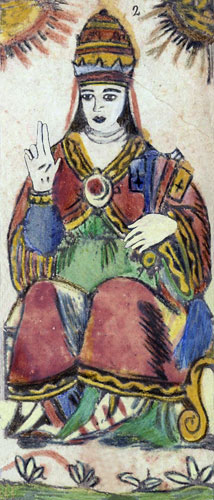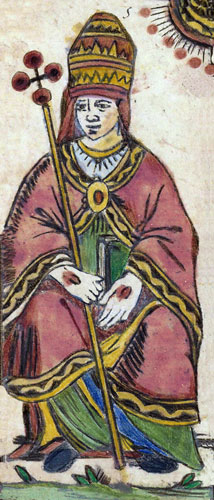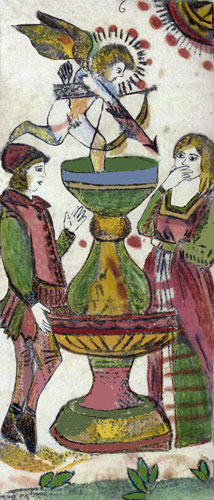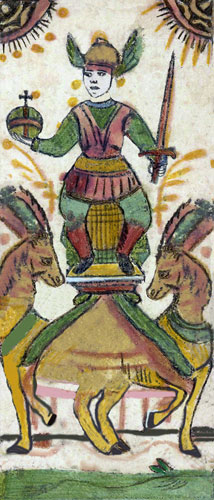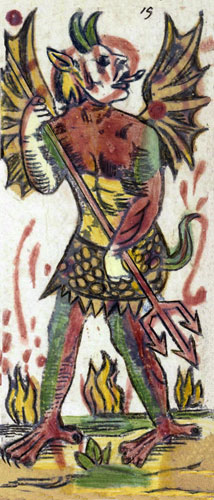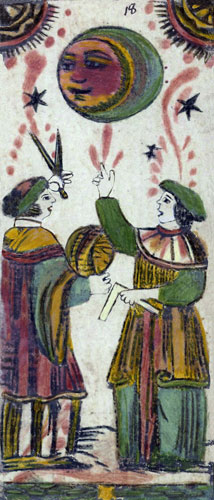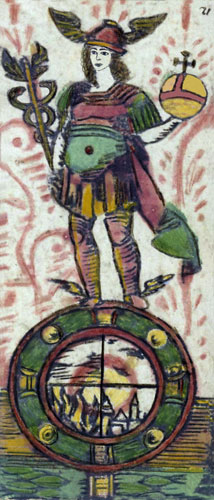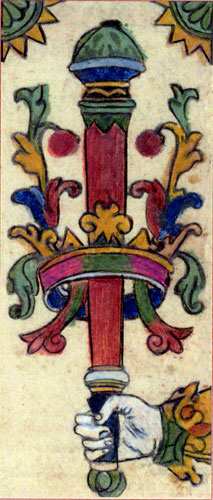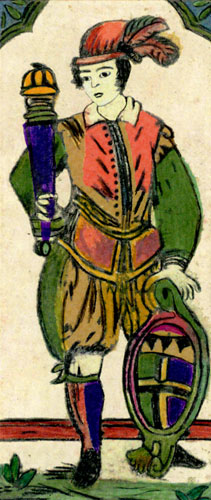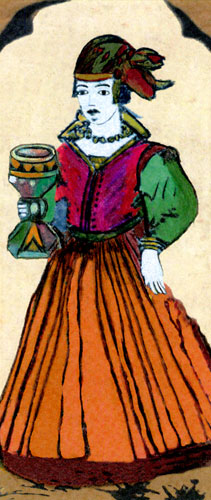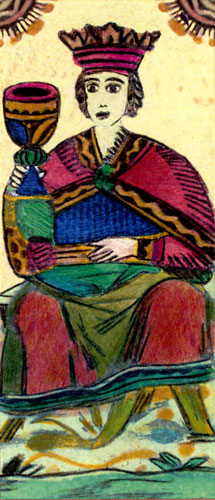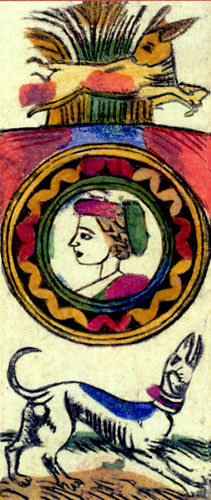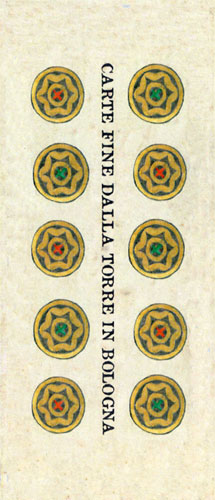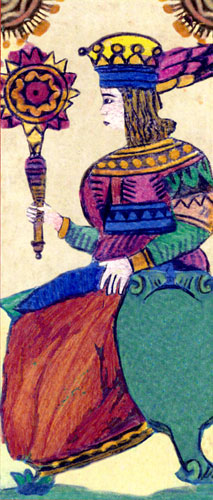XVII Century Tarot of Bologna
Number of Cards: 78 + Title Card, Signed & Numbered
Leaflet: English (Edited by Arnell Ando), Describes Historical Nature of this Important Deck
Published by Museo Dei Tarocchi - Mutus Liber, 1st Ed. 2016, 2nd Ed. 2018
Printed on Thick, Softly Textured, Matte Cardstock
Card Size: 2.75" Wide x 5.75" Long (7 x 14.6 cm.)
Cards: Have a Cream Border, Majors are Numbered, Untitled
Back Design: Shown Below, Not Reversible
1st Edition (2016 - OOP): Came in Wooden Box with Sliding Lid: €. 75 Euro + Italian Postage
2nd Ed (2018) Same Cards, Shrink-wrapped in Flip-top Box, Limited to 500 Signed & Numbered Sets: €. 60 Euro + Italian Postage
AFTER 400 YEARS AN IMPORTANT HISTORICAL TAROT DECK COMES BACK TO LIFE!
* Excellent Review by Historian of 'Tarot Heritage', Sherryl E. Smith
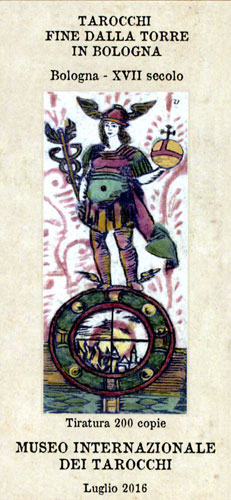
* Wonderful, detailed Walkthrough by Elle of Sacred Seed (25 minutes)
* Great Unboxing by Tom Benjamin (Begins 20:50 into video)
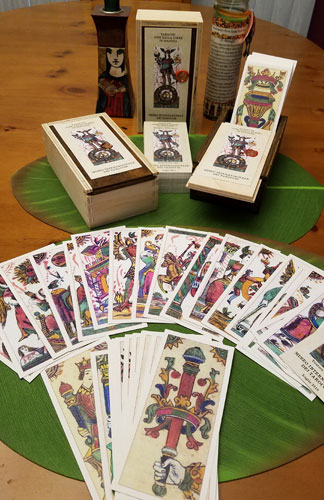 Fine Dalla Torre of Bologna,
first republished by the Tarot Museum, Summer 2016...
This is an exceptionally well crafted set presented by Museo dei Tarocchi, which does a Tarot scholar & collector proud. The 78-card deck comes neatly shrink-wrapped and nestled on a bed of straw in a
stylish wooden box (most come nude, with stained lid) and title card, hand-stamped with hot wax seal, fastened to the lid. The cardstock is sturdy yet softly textured and feels comfortable
(tactile) whilst shuffling. It is an important historical deck that scholars have requested for quite some time, so the Tarot Museum aimed to offer an exemplary version for a reasonable price.
Just as the popular, wooden box set was going Out of Print, the Tarot Museum also made available a simpler, more affordable 2nd Edition in a flip-top box, but fortunately,
with same high quality, matte cardstock (card size is same too). This newer version is
limited to 500 sets which are also signed & numbered (in the enclosed leaflet).
Fine Dalla Torre of Bologna,
first republished by the Tarot Museum, Summer 2016...
This is an exceptionally well crafted set presented by Museo dei Tarocchi, which does a Tarot scholar & collector proud. The 78-card deck comes neatly shrink-wrapped and nestled on a bed of straw in a
stylish wooden box (most come nude, with stained lid) and title card, hand-stamped with hot wax seal, fastened to the lid. The cardstock is sturdy yet softly textured and feels comfortable
(tactile) whilst shuffling. It is an important historical deck that scholars have requested for quite some time, so the Tarot Museum aimed to offer an exemplary version for a reasonable price.
Just as the popular, wooden box set was going Out of Print, the Tarot Museum also made available a simpler, more affordable 2nd Edition in a flip-top box, but fortunately,
with same high quality, matte cardstock (card size is same too). This newer version is
limited to 500 sets which are also signed & numbered (in the enclosed leaflet).
UNPUBLISHED IN THE MODERN ERA UNTIL NOW...
From the start, the Tarot Museum had the goal of publishing an important Italian deck that hadn't seen the light of day in contemporary times . Something not too distant from the model that gave rise to the 18th century iconic illustrations of the so-called Tarot of Marseilles; (well-known to Tarot enthusiasts) and consequently extremely influential over decks published during subsequent centuries. They decided upon the 17th century Bolognese deck known as Tarocchi Fine Dalla Torre, which luckily was passed down nearly complete and in fairly good condition. The only known example of this noteworthy deck is preserved as the “Tarot Bolonais XVIIe s.” by the Bibliothèque Nationale in Paris.
The original card size was 43 x 105 mm. (1.7 x 4.1 inches) and the Majors were printed unnumbered (although became numbered by hand afterwards). In this new edition the card size is quite a bit larger: 2.75 W x 5.75 inches L (7 x 14.6 cm.) which makes viewing details that much more enjoyable.
Being a Bolognese style deck, at the time of the original publication meant it would be reduced from the traditional Tarot deck of seventy-eight cards, to only sixty-two (eliminating the Minor Arcana numbered: 2, 3, 4 and 5 of each suit), following the custom in vogue since at least the mid-16th century in Bologna. Of the original sixty-two cards, only six remain lost to time: 6, 7, 8 & 9 of Swords, the Queen of Cups and the Queen of Coins. For this special Tarot Museum production, all 78 Tarot cards have been included, so you have the option of reducing it to its original Bolognese number or using the full set (decks which represent the Marseilles style have symbols on the pip cards rather than scenes, although some of these Minors, especially the Aces are quite elaborate).
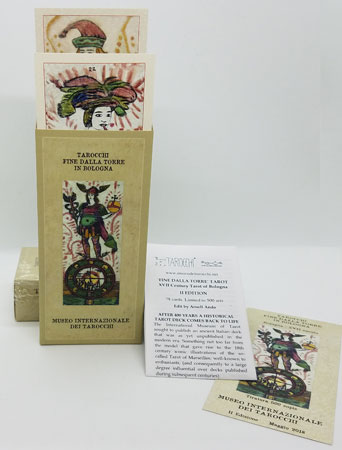
According to text in the accompanying leaflet, shared by Giovanni Pelosini (from his groundbreaking work entitled TAROT MIRRORS OF INFINITY),this deck is similar to modern successors, such as the Tarocchino Bolognese, but at the same time, it has many resemblances to its ancestors of the 16th century (with the notable exception of the Devil card); at least with regards to the twelve surviving images of Trumps on two incomplete sheets from the last decade of the 15th century. The first is in the Bibliotheque de l'Ecole Nationale Superieure des Beaux-Arts, Masson Collection, of Paris (uncatalogued). The second is in Musée du Louvre, Rothschild Collection, LR 3804, also of Paris.
MORE CURIOUS BITS ABOUT THIS PRECIOUS ITALIAN DECK
Continuing with details from the included leaflet, in this ancient deck there are still traditional depictions of the High Priestess, Empress, Emperor and Pope, that were viewed unfavorably (at that time), by authorities of the Papal States, and which were subsequently replaced in Tarocchino Bolognese; first by two Popes and two Emperors (by at least 1669) and eventually by images of the four "Moors", during the late 17th century. From the perspective of symbolism, this deck shows interesting details, particularly when compared to the traditional portrayal of the cards. The High Priestess and Pope are perhaps the most remarkable cards of the Major Arcana. The High Priestess holds Keys and makes a blessing with a Latin gesture, while the Pope has a closed book and holds a cross. The latter also reveals a stigmata on his hands, and has a youthful, beardless face that is decidedly feminine. The details of his Papal Tiara (a triple crown without button or cross) suggest a hypothetical design dating between 1342 and 1503.
All face cards of the Major Arcana are interesting from a historic and symbolic perspective, while the Court Cards consistently reflect complementary qualities of courtly pairings in an aesthetically pleasing manner. The distinction between male suits (Wands and Swords) and female (Cups and Coins) is all too evident with the obvious presence of two female chambermaids. However, there are many other significant details, such as attire, attributes, poses and their ageless appearance. The 10 of Coins has the inscription “CARTE FINE DALLA TORRE IN BOLOGNA” with 17th century typography. These words are displayed vertically (card shown below). Most likely one of many heirs of an abundant production, documented in Bologna with the manufacturer Pietro Bonozzi since at least 1477, while their actual presence was certified in town since at least 1459 (refer to the Tarot Travel Guide of Italy, 2015, page 50, by Morena Poltronieri, Ernesto Fazioli & Arnell Ando).
THE CARD BACKS
As recorded in the set's helpful leaflet, the card backs feature two winged angels. One is the classic Cupid with bow and arrow, while the other points to a large tree with a heart hanging like fruit. This is probably a reference to the myth of Apollo and Daphne; both struck by the arrows of Eros, but with opposite results. Apollo fell instantly in love with Daphne, while she flatly refused his advances, even after a long chase through the woods. So as not to give in to the passions of the ‘God of Oracles', the desperate nymph prayed for an escape and was thus transformed into the sweetly scented laurel plant, hereafter known as "Daphne" in Greek and which consequently became the symbolic tribute to the great poets of Ancient Greece.
WORK ON THE CARDS
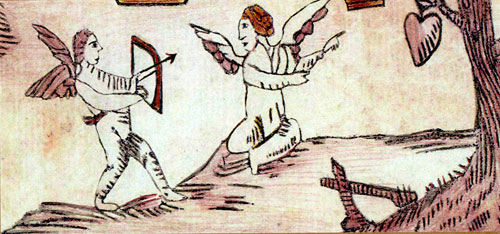
From April 2014 Morena Poltronieri and Ernesto Fazioli (of Museo dei Tarocchi) began the challenging task of returning this precious Bolognese Tarot of the 17th century back to production. The original fifty-six cards of the Bibliotheque Nationale (in Paris) were engraved on wood with a colorful façade. Poltronieri and Fazioli worked on the images digitally, through various color definition phases, both with pastels and by utilizing computer graphics. They defined the contours and colors using professional pastels. The refined images were then set in Photoshop to clean up any smudges caused by time and wear. One of the goals was not to interfere creatively with the look of these cards, but instead to preserve their original freshness, which was so characteristic of the era, while also being a distinctive work. The end result is respectful of the unique designs, contours and colors, while adding a greater definition to the beauty and charm inherent in the original imagery. The missing Queens (Cups and Coins) have been redesigned and processed through Photoshop, referring to the double sided, Court Cards of 18th century, Tarocchino Bolognese, that is part of the permanent collection of the Tarot Museum.
Morena & Ernesto feel the fruit of their labor will be in the sharing of one of the most important Italian Tarot decks of the distant past. After nearly four centuries, this quintessential 17th century deck is finally available and that is worth celebrating!

